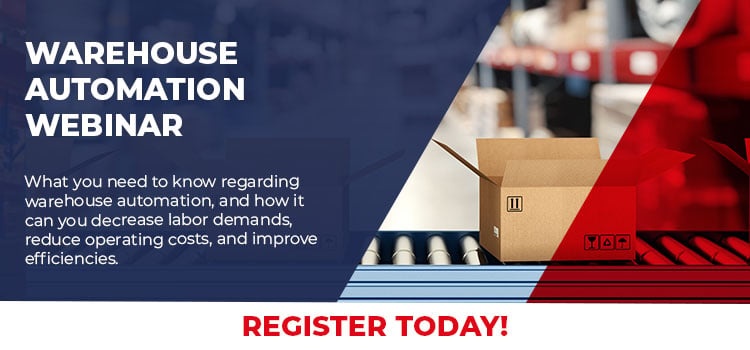With the ongoing labor constraints and companies continually seeking various ways to implement automation to reduce their demand for labor, warehouse automation and technology has become more prevalent.
One of the first areas that companies typically automate is their shipping department. Shipping automation eliminates manual functions beginning in packing, all the way until packages are sorted down to the correct outbound lane, pallet, or truck.
Shipping automation is also one of the first areas to be looked at since it can be justified from a cost standpoint by a wide range of companies – even those shipping as few as 1,500 to 2,000 shipments per day.
It is not uncommon to see companies where the packer and/or shipper is responsible for selecting the proper shipping carton size, packing the items, inserting dunnage as well as packing slips and additional information, sealing the carton, weighing it, and applying a shipping label. Typically, these tasks can add significant time to the overall pack-out and shipping process which increases the need for labor and drives up costs. Shipping automation can alleviate most of these steps.
With shipping automation, companies can remove these manual steps – and at times, do it in phases as well. Shipping automation usually consists of the following capabilities which can be implemented at the same time, or in a phased approach over time.
Cartonization
This is a function that usually sits within most warehouse management systems (WMS). Cartonization at a high level is a math equation. The algorithms that drive the math within the WMS allow companies to suggest the most adequate carton size based on the input of what product and how much dunnage is needed. This helps to reduce the frequency of packers selecting a larger than needed box which in turn also helps to reduce dimensional weight issues and costs with carriers. It also takes away the extra time spent deciding which box to use, thus making the packer more efficient. Cartonization is not necessarily one of the easier aspects to implement as it requires companies to have (and maintain) the cubic dimensional data for all SKUs and the different outbound cartons being used.
Box Dimensioner
Getting accurate box dimensions is important. For many companies, they capture the boxes' outer dimensions, but this is the box size without product in it. As we all know, packers may overfill a carton causing the box sides to bulge or push out. A box dimensioner pulls the actual box dimensions with a series of lasers for the most accurate dimensions. As a box moves down the conveyor line, a scan is made of the shipment ID, and the dimensions are taken and associated with the shipment ID – all while the box remains in motion. This, like cartonization, helps to reduce freight spend and eliminate any potential fees the carrier may impose.
Weigh-in-Motion Scales
Another manual function that can be removed from the packing process is capturing the shipment weight. After the carton dimensions are taken, the shipment travels across a weigh-in-motion scale to capture the actual weight. This process can also serve as a secondary audit of the shipment to determine if it is within an acceptable weight range.
To do this, companies need to maintain each SKUs actual weight, and in the case of an order being split into several shipments, the system needs to communicate which items are in which shipment. In addition, a tolerance would need to be set to account for the weight of dunnage in the shipment.
If a shipment crossing the weigh-in motion scale is out of tolerance from the expected weight, the shipment would be diverted down a hospital lane to be evaluated later in the process. This additional audit can capture any mistakes not caught by picking or packing.
Print and Apply
Once the box dimensions and weight are validated, companies can establish business rules for selecting the actual ship method. Shipping automation can support all rules for rate shopping/best way shipping. Most smaller installs typically run a single print head for applying labels, while larger installs will contain multiple print heads to keep up with the shipment volume.
There is flexibility in these print units to support a wide variety and formats of shipping labels, including a two-part label that incorporates a packing slip under the shipping label.
Additionally, if you require a special ORMD sticker or something similar to be applied to the side of the shipping carton, the same technology for ship labels can be utilized for these scenarios.
Shipping Lanes and Diverts
After the shipping label has been applied, the final step that can be automated is sorting that shipment to the correct location. Oftentimes, this is as simple as lanes to a series of dock doors that represent different carriers or different levels of service (i.e., overnight vs ground). The shipping automation line knows via scan which outbound lane that shipment needs to be in and at the right time applies a divert to the correct lane.
This helps aid in the accuracy of getting all expedited shipments to the right dock door and not accidentally leaving one behind. It also prevents an individual from having to inspect every shipping label and then making sure it is placed on the right pallet, for example. In addition, there would also be a hospital lane to support shipments that didn’t get a good read or errored out.
Shipping automation can greatly reduce labor costs throughout the process. Companies will need to understand the current costs so that they can be evaluated against the cost of automation. Ensuring a sufficient return on investment is critical to meeting management's objectives when seeking approval for these types of projects.






SHARE